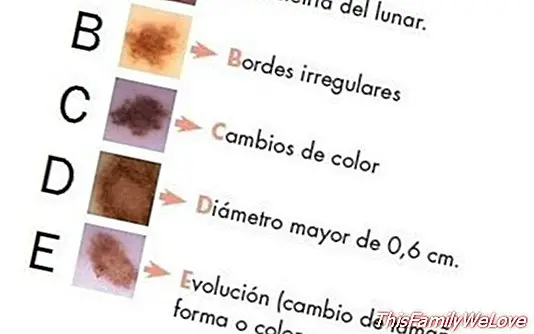The ABCDE of the moles: when to go to the dermatologist
Melanoma continues to grow at an annual rate of 10% (5,000 new cases per year), however the mortality rate is decreasing at a rate of 2.5% per year in those under 50 years of age, while in older people the decrease Annual is 1%. Self-exploration following the ABCDE rule of moles is essential to stop it in time.
"This is another example of the fact that the elderly group is the most unprotected against skin cancer: either because of the embarrassment of getting naked to have a digital dermatoscopy, or because they believe that the spots on the skin are their own. age, either because they do not self-browse following the ABCDE rule of moles or because they do not have anyone who can review them, for example, their backs, the fact is that they are the ones with the most advanced skin cancers. And as a dermatologist I think we should make them aware of the value of early detection of skin cancer, as they certainly do for breast or prostate cancer, "says the director of the Institute of Integral Dermatology.
Early detection of skin cancer
Digital dermatoscopy, accompanied by a body mapping of moles, has proven to be the most effective test for early detection of skin cancer. It is a non-invasive method, which can be done by all people, allows to control in a very precise way the evolution of moles and other suspicious lesions before they even degenerate into a skin cancer. Performing this test annually in people at risk, facilitates early diagnosis and, therefore, healing.
"Body mapping and digital dermatoscopy are performed using digital photography equipment that makes a serial map of our skin, associated with the detection by surface microscopy of suspicious lesions, storing the images for follow-up and subsequent comparison. digital dermatoscopy analyzes the shape, color, diameter and evolution of moles, making it easier to make a decision at every moment ", says Miguel Sánchez Viera.
Rule of the ABCDE of polka dots

The ABCDE of moles (nevus) is an international mnemonic rule that allows us in a simple way to know what kind of things we have to take into account when exploring and analyzing the moles that we have in our body.
Brake to melanoma: 4 tips to prevent skin cancer
The main preventive measure is the protection against solar radiation and artificial sources of UVA rays, mainly the tanning beds of UVA rays.
- Do not expose yourself to the sun without photoprotection, at least with an SPF of at least 30, although it is more effective than 50. This includes when we are in beaches and swimming pools, we go on excursions, do sports outdoors or spend a morning fixing the garden, for example.
- Avoid the sun in the central hours of the day, from 12:00 to 17:00 hours. If it is not possible, always do it with photoresists (renewing it every 2 hours), using hats, hats and clothes that protect us from the sun and being most of the time in the shade.
- Do not expose children under 3 years of age to the sun, since they have very sensitive and delicate skin and their defensive system is in the process of formation.
- Do not use UVA tanning booths
Checking of moles
Skin cancer is the cancer with the highest number of annual cases. In fact, according to figures from the Skincancer Foundation, 1 in 5 people will have developed skin cancer when they reach 70 years old. However, while social awareness campaigns have penetrated the young population, this has not been the case in an ever wider group.
"We have a very defined profile of a patient with skin cancer with a very high risk: it is that of the elderly person, man or woman, with clear skin, who has overexposed the sun a lot, either for work or leisure, who has large spots, even some with a history of skin cancer, and that the body is not screened for, precisely, spots or moles because, in many cases, they consider them to be age-specific, "explains Dr. Miguel Sánchez Viera, director of the Institute of Cancer. Integral dermatology.
This type of patients does not usually go to the dermatologist routinely to get a polka check, but goes when the spot or the mole, which ends up being an advanced skin cancer, is in an area that they can see and is very large , it causes them a lot of discomfort, or by chance, someone from their closest environment detects the mole and accompanies them to the dermatologist. "They are people who come to the clinic with melanomas and squamous cell carcinomas with metastases and with large basal cell carcinomas that involve very aggressive surgeries with reconstructions or grafts.Part of this problem could be avoided by making awareness campaigns aimed at this group, as we have seen that in the group of patients under 50 have worked, repeat the experience with them, "says Dr. Sánchez Viera.
Marina Berrio
Advice: Dr. Miguel Sánchez Viera, director of the Institute of Integral Dermatology




